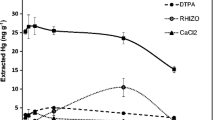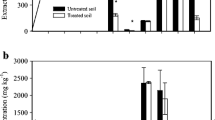Abstract
In this study, we compared the size of the mobile Hg pool in soil to those obtained by extractions using 2 M HNO3, 5 M HNO3, and 2 M HCl. This was done to evaluate their suitability to be used as proxies in view of Hg uptake by ryegrass. Total levels of Hg in soil ranged from 0.66 to 70 mg kg−1 (median 17 mg kg−1), and concentrations of Hg extracted increased in the order: mobile Hg < 2 M HNO3 < 5 M HNO3 < 2 M HCl. The percentage of Hg extracted relative to total Hg in soil varied from 0.13 to 0.79 % (for the mobile pool) to 4.8–82 % (for 2 M HCl). Levels of Hg in ryegrass ranged from 0.060 to 36 mg kg−1 (median 0.65 mg kg−1, in roots) and from 0.040 to 5.4 mg kg−1 (median 0.34 mg kg−1, in shoots). Although results from the 2 M HNO3 extraction appeared to the most comparable to the actual total Hg levels measured in plants, the 2 M HCl extraction better expressed the variation in plant pools. In general, soil tests explained between 66 and 86 % of the variability of Hg contents in ryegrass shoots. Results indicated that all methods tested here can be used to estimate the plant total Hg pool at contaminated areas and can be used in first tier soil risk evaluations. This study also indicates that a relevant part of Hg in plants is from deposition of soil particles and that splashing of soil can be more significant for plant contamination than actual uptake processes.

Illustration of potential mercury soil-plant transfer routes




Similar content being viewed by others
References
Bloom NS, Preus E, Katon J, Hiltner M (2003) Selective extractions to assess the biogeochemically relevant fractionation of inorganic mercury in sediments and soils. Anal Chim Acta 479:233–248
Brand E, Peijnenburg W, Gronenberg B et al. (2009) Towards implementation of bioavailability measurements in the Dutch regulatory framework. RIVM Report 711701084
Costley CT, Mossop KF, Dean JR, Garden LM, Marshall J, Carroll J (2000) Determination of mercury in environmental and biological samples using pyrolysis atomic absorption spectrometry with gold amalgamation. Anal Chim Acta 405:179–183
Degryse F, Vlassak V, Smolders E, Merckx R (2007) Mobilization of Cd upon acidification of agricultural soils: column study and field modelling. Eur J Soil Sci 58:152–165
EC (European Commission) (2002) Directive 2002/32/EC of the European Parliament and of the Council of 7 May 2002 on undesirable substances in animal fee
Fernández-Martínez R, Rucandio MI (2005) Study of the suitability of HNO3 and HCl as extracting agents of mercury species in soils from cinnabar mines. Anal Bioanal Chem 381:1499–1506
Fernández-Martínez R, Loredo J, Ordóñez A, Rucandio MI (2005) Distribution and mobility of mercury in soils from an old mining area in Mieres, Asturias (Spain). Sci Total Environ 346:200–212
Fernández-Martínez R, Larios R, Gómez-Pinilla I, Gómez-Mancebo B, López-Andrés S, Loredo J, Ordóñez A, Rucandio I (2015) Mercury accumulation and speciation in plants and soils from abandoned cinnabar mines. Geoderma 253–254:30–38
Guney M, Welfringer B, de Repentigny C, Zagury GJ (2013) Children’s exposure to mercury-contaminated soils: exposure assessment and risk characterization. Arch Environ Contam Toxicol 65(2):345–355
Han Y, Kingston HM, Boylan HM, Rahman GMM, Shah S, Richter RC et al (2003) Speciation of mercury in soil and sediment by selective solvent and acid extraction. Anal Bioanal Chem 375:428–436
Han FX, Su Y, Monts DL, Waggoner CA, Plodinec MJ (2006) Binding, distribution, and plant uptake of mercury in a soil from Oak Ridge, Tennessee, USA. Sci Total Environ 368(2-3):753–768
Henriques B, Rodrigues SM, Cruz N, Coelho C, Duarte AC, Römkens PFAM, Pereira E (2013) Risks associated with the transfer of toxic organo-metallic mercury from soils into the terrestrial feed chain. Environ Int 59:408–417
Houba VJG, Temminghoff EJM, Gaikhorst GA, Van Vark W (2000) Soil analysis procedures using 001 M calcium chloride as extraction reagent. Commun Soil Sci Plan Anal 31:1299–1396
Inacio M, Pereira V, Pinto M (2008) The soil geochemical atlas of Portugal: overview and applications. J Geochem Explor 98:22–33
ISO (1994) Soil quality - determination of pH. ISO 10390:1994
ISO (1995) Soil quality - determination of organic and total carbon after dry combustion (elementary analysis). ISO 10694:1995
Issaro N, Abi-Ghanem C, Bermond A (2009) Fractionation studies of mercury in soils and sediments: a review of the chemical reagents used for mercury extraction. Anal Chim Acta 631:1–12
Jing YD, He ZL, Yang XE, Sun CY (2008) Evaluation of soil tests for plant available mercury in a soil-crop rotation system. Commun Soil Sci Plan 39:3032–3046
Krauss M, Wolfgang W, Kobza J, Zech W (2002) Predicting heavy metal transfer from soil to plant: potential use of Freundlich-type functions. J Plant Nutr Soil Sci 165:3–8
Meers E, Samson R, Tack FMG, Ruttens A, Vandegehuchte M, Vangronsveld J, Verloo MG (2007) Phytoavailability assessment of heavy metals in soils by single extractions and accumulation by Phaseolus vulgaris. Environ Exp Botany 60:385–396
Meng B, Feng X, Qiu G, Wang D, Liang P, Li P et al (2012) Inorganic mercury accumulation in rice (Oryza sativa L.). Environ Toxicol Chem 31:2093–2098
Millán R, Gamarra R, Schmid T, Sierra MJ, Quejido AJ, Sánchez DM, Cardona AI, Fernández M, Vera R (2006) Mercury content in vegetation and soils of the Almadén mining area (Spain). Sci Total Environ 368:79–87
Peijnenburg WJGM, Zablotskaja M, Vijver MG (2007) Monitoring metals in terrestrial environments within a bioavailability framework and a focus on soil extraction. Ecotox Environ Saf 67:163–179
Pereira E, Rodrigues SM, Otero M, Válega M, Lopes CB, Pato P, Coelho JP, Lillebø AI, Pardal MA, Rocha R, Duarte AC (2008) Evaluation of an interlaboratory proficiency-testing exercise for total mercury in environmental samples of soils, sediments and fish tissue. TRAC-Trend Anal Chem 27:959–970
Reis AT, Rodrigues SM, Araújo C, Coelho JP, Pereira E, Duarte AC (2009) Mercury contamination in the vicinity of a chlor-alkali plant and potential risks to local population. Sci Total Environ 407:2689–2700
Reis AT, Rodrigues SM, Davidson CM, Pereira E, Duarte AC (2010) Extractability and mobility of mercury from agricultural soils surrounding industrial and mining contaminated areas. Chemosphere 81:1369–1377
Reis AT, Coelho JP, Rodrigues SM, Rocha R, Davidson CM, Duarte AC, Pereira E (2012) Development and validation of a simple thermo-desorption technique for mercury speciation in soils and sediments. Talanta 99:363–368
Reis AT, Duarte AC, Henriques B, Coelho C, Lopes CB, Mieiro CL, Tavares DS, Ahmad L, Coelho JP, Rocha LS, Cruz N, Monteiro RJR, Rocha R, Rodrigues S, Pereira E (2015a) An international proficiency test as a tool to evaluate mercury determination in environmental matrices. Trac- Trend Anal Chem 64:137–149
Reis AT, Coelho JP, Rucandio I, Davidson CM, Duarte AC, Pereira E (2015b) Thermo-desorption: a valid tool for mercury speciation in soils and sediments? Geoderma 237:98–104
Rodrigues SM, Henriques B, da Silva EF, Pereira ME, Duarte AC, Römkens PFAM (2010) Evaluation of an approach for the characterization of reactive and available pools of twenty potentially toxic elements in soils: part i—the role of key soil properties in the variation of contaminants’ reactivity. Chemosphere 81(11):1549–1559
Rodrigues S, Henriques B, Reis A, Duarte A, Pereira E, Römkens PFAM (2012a) Hg transfer from contaminated soils to plants and animals. Environ Chem Lett 10:61–67
Rodrigues SM, Pereira ME, Duarte AC, Römkens PFAM (2012b) Soil–plant–animal transfer models to improve soil protection guidelines: a case study from Portugal. Environ Int 39:27–37
Rodrigues SM, Pereira ME, Duarte AC, Römkens PFAM (2012c) Derivation of soil to plant transfer functions for metals and metalloids: impact of contaminant’s availability. Plant Soil 361:329–341
Rodrigues SM, Coelho C, Cruz N, Monteiro RJR, Henriques B, Duarte AC, Romkens PFAM, Pereira E (2014) Oral bioaccessibility and human exposure to anthropogenic and geogenic mercury in urban, industrial and mining areas. Sci Total Environ 496:649–661
Römkens PFAM, Guo HY, Chu CL, Liu TS, Chiang CF, Koopmans GF (2009) Characterization of soilmetal pools in paddy fields in Taiwan: chemical extraction and solid-solution partitioning. J. Soil Sediment 9:216–228
Rothenberg SE, Fenf X, Zhou W, Tu M, Jin B, You J (2012) Environment and genotype controls on mercury accumulation in rice (Oryza sativa L.) cultivated along a contamination gradient in Guizhou, China. Sci. Total Environ 426:272–280
Rytuba JJ (2003) Mercury from mineral deposits and potential environmental impact. Environ Geol 43:326–338
US EPA (1998) Test methods for evaluating solid waste, physical/chemical methods, SW-846. US Government Printing Office, Washington, DC
Válega M, Lima AIG, Figueira EMAP, Pereira E, Pardal MA, Duarte AC (2009) Mercury intracellular partitioning and chelation in a salt marsh plant, Halimione portulacoides (L.) Aellen: strategies underlying tolerance in environmental exposure. Chemosphere 74:530–536
Zhou J, Liu H, Du B, Shang L, Yang J, Wang Y (2015) Influence of soil mercury concentration and fraction on bioaccumulation process of inorganic mercury and methylmercury in rice (Oryza sativa L.). Environ Sci Pollut Res Int 22(8):6144–6154
Acknowledgments
S.M. Rodrigues and B. Henriques acknowledge the financial support from the Portuguese Foundation for Science and Technology (FCT) (Project IF/01637/2013/CP1162/CT0020 and postdoctoral grant SFRH/BPD/112576/2015, respectively). Authors acknowledge the financial support of both FCT and “COMPETE” program through Project FCOMP-01-0124-FEDER-02800 (FCT PTDC/AGR-PRO/4091/2012).
Author information
Authors and Affiliations
Corresponding author
Additional information
Responsible editor: Elena Maestri
Highlights
• Soil extraction tests can be used as proxies in view of Hg uptake by ryegrass
• The 2 M HCl extraction better expressed the variation in plant pools
• Deposition of soil can be significant for plant contamination in addition to uptake
• Soil extraction testes can be used in first tier soil risk evaluations for Hg
Electronic supplementary material
Below is the link to the electronic supplementary material.
ESM 1
(DOC 50 kb)
Rights and permissions
About this article
Cite this article
Monteiro, R.J.R., Rodrigues, S.M., Cruz, N. et al. Advantages and limitations of chemical extraction tests to predict mercury soil-plant transfer in soil risk evaluations. Environ Sci Pollut Res 23, 14327–14337 (2016). https://doi.org/10.1007/s11356-016-6564-x
Received:
Accepted:
Published:
Issue Date:
DOI: https://doi.org/10.1007/s11356-016-6564-x




